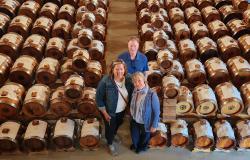Move over Champagne – Italy’s Prosecco may well become everybody’s new favorite fizz.
Starting in 2013, Prosecco production has outpaced Champagne; not only that, Prosecco sales outside of Italy have seen a sharp increase: in the UK for example, they increased by 72% and have surpassed Champagne sales this year for the first time; in the US, they increased by 35%. Surely, it helps that Prosecco is much cheaper than Champagne – the average price per bottle is $12 or less.
But that's not the only reason. Italian sommelier Diego Meraviglia described well the reasons for Prosecco's increasing success: “It's an expression of the Made in Italy, it's affordable, it offers Italian conviviality at a reasonable price.” Plus, I'd add, it’s easy to like. Fresh, light and fruity with aromas of white flowers, green apple and citrus fruits, it's versatile and pairs well with aperitif snacks (no wonder it’s one of the Italians’ wine of choice during aperitivo), but also with seafood and poultry. And it’s just perfect for cin cin – we often use it here in Italy as a toasting wine, at parties, celebrations and of course over the holidays.
Produced in the north-east of Italy, precisely in nine provinces distributed between the regions of Veneto and Friuli Venezia Giulia, Prosecco is made with 85 percent or more of the white Glera grape. Its production differs from Champagne mainly in the secondary fermentation process, which takes place in a large tank, rather than in the bottle, following the so-called Charmat-Martinotti method. This alters the organoleptic properties of the wine, making it fresh and fruity, not yeasty, with larger and shorter-lived bubbles than Champagne; it also makes it cheaper to produce. (There’s an exception to this for the DOCG-designated wines, which allow the use of the Metodo Classico, i.e. secondary fermentation in the bottle, the method used for Champagne; incidentally, Prosecco Superiore DOCG can only be made in the Treviso province of Veneto on the hills between the towns of Conegliano and Valdobbiadene).
Demand for Prosecco is expected to remain high, and with the holiday season in full swing, we bet many Prosecco bottles will be popped open this year, and not just in Italy. So cin cin to 2016!

